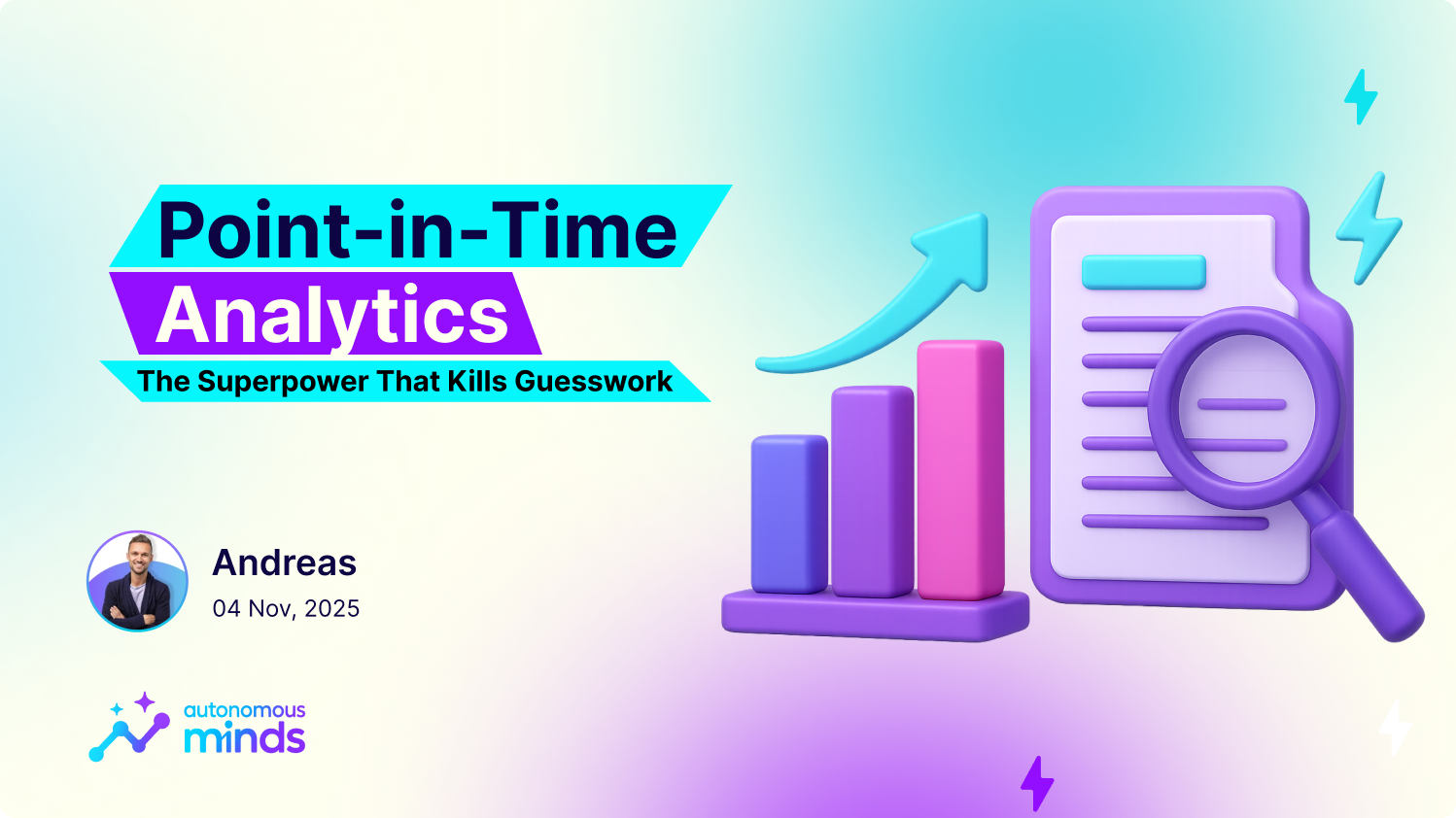Why PiT matters (and why most teams don’t have it)
Every operator eventually asks: “What changed since the last review?” Traditional BI often can’t answer cleanly because:
- Source systems overwrite fields (you lose the previous value),
- Time-series modeling is manual and narrow (you track a few metrics, not the whole object),
- Analysts end up rebuilding “as of” snapshots in spreadsheets.
Generative BI changes the baseline. Platforms like Milo maintain an AI data layer that understands your organization in near real time and enriches raw data with metadata about changes. Instead of blindly calling tools, the platform assigns versioning metadata to objects, so you can query how a record looked at time T (a true point-in-time view) across any data object, not just prebuilt time series.
Excurse: time-series vs. non-time-series data
- Time-series data (e.g., hourly revenue, daily signups) already comes with timestamps per measurement. Comparing “now vs last week” is straightforward because each row is a dated observation.
- Non-time-series data (e.g., a Salesforce Opportunity, a Contract, a Support Ticket) mutates in place. Without snapshots or audit tables, you can’t reliably answer “what was the stage/amount/owner last Monday?”
PiT solves the second case by storing the state changes (and related metadata) so you can reconstruct any object as of a past point, no spreadsheet archaeology required.
How Generative BI enables PiT (without heavy lifting)
- AI data layer, not just connectors: Instead of pass-through queries, the platform ingests and enriches objects with change metadata (who/what/when/diff).
- Versioned objects: Each business object (Opportunity, Account, Campaign, Ticket, etc.) gets immutable versions when meaningful fields change.
- PiT query helpers: You can ask in plain English, “Show the pipeline as of last Monday” or “Compare the as of views between last review and today”, and get a precise, auditable answer.
- Side-effects ready: Once you know what changed, you can trigger actions (Slack summaries, PDFs, CRM tasks) with approvals and audit, closing the loop in minutes.
Example 1: Sales pipeline (now vs. last week vs. last review)
You want to know how your pipeline shifted since the last call: which deals moved stage, which amounts changed, which risks appeared, and where leakage occurred.
With a PiT-capable Generative BI layer:
- Rebuild the pipeline “as of” a date/time (e.g., last Monday 09:00).
- Diff the objects: “These 14 opportunities slipped stage; these 6 increased ARR; these 4 lost owners.”
- Explain the drivers: e.g., push-outs in Mid-Market EMEA, discount approvals pending in Enterprise, two reps with high cycle-time variance.
- Act: auto-create owner tasks in CRM, send a manager Slack summary, and export a board-ready PDF.
Many firms try to hack this with CRM snapshots or premium features; PiT delivers it out of the box at the analytics layer, no spreadsheet tracking or expensive enterprise add-ons.
As a comparison: if you want a simple PiT comparison in Salesforce, you would need an expensive Enterprise license for this feature only (and for Salesforce only of course).
Example 2: Non-time-series PiT - Contracts & Support Tickets
- Contracts: Compare as of versions to see when renewal terms, seat counts, or pricing changed; generate a one-page diff for Legal/Finance with who/what/when.
- Support Tickets: Rebuild a ticket’s state at incident time and at escalation time; quantify SLA breaches, ownership changes, and root-cause tags at each as of moment, no manual reconstruction.
Because the AI data layer versions the whole object, PiT works across domains (Sales, CS, Finance, Risk) without custom snapshot tables each team must maintain.
Business outcomes PiT unlocks
- Answer “what changed?” instantly: Kill the meeting spent reconciling versions.
- Auditable history by default: Every comparison comes with metadata and a verifiable “diff.”
- Faster time-to-action: When differences are clear, assigning owners and next steps takes minutes, not days.
- Fewer data fights: One as of truth reduces disputes between teams and tools.
- Lower cost & complexity: Avoid custom snapshot pipelines and sprawling spreadsheets; keep analysts focused on edge cases.
What to look for in a PiT-capable Generative BI platform
- Native AI data layer (not just pass-through to your warehouse).
- Automatic change tracking with versions and field-level diffs.
- Plain-English PiT queries (“as of”, “compared to last review”).
- Governed actions (Slack/Email/CRM/PDF) with approvals, audit, and undo.
- Short retention & privacy controls (no model training on your data).
Generative BI isn’t only about asking in natural language. With Point-in-Time baked into the data layer, it turns “what changed?” into evidence, and then into actions your teams can trust.

